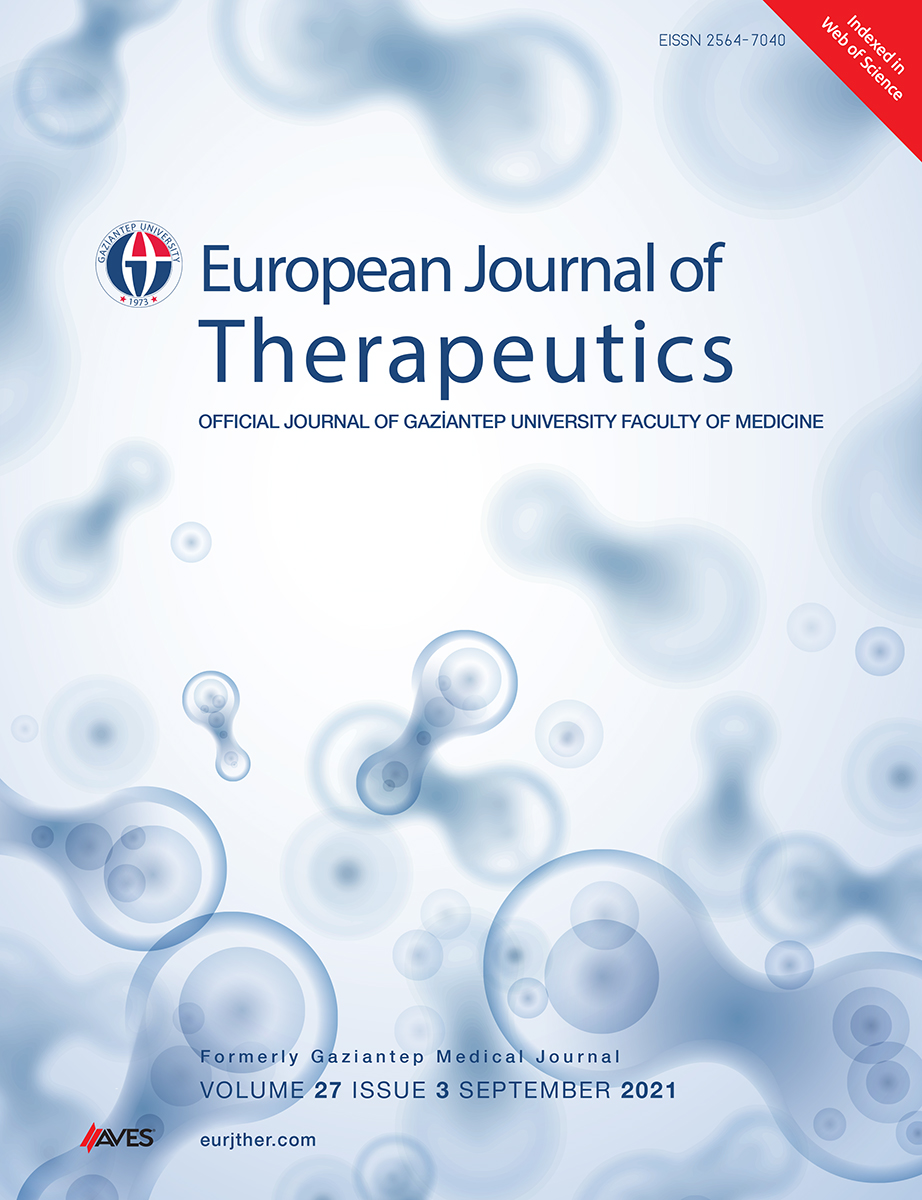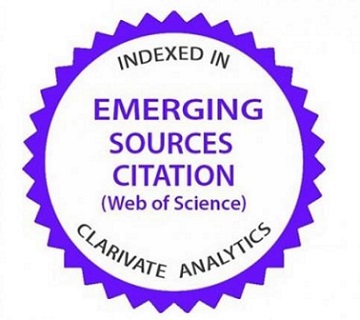The Effect of Acromiohumeral Distance on Isolated Supraspinatus Tendon Tear Repair
DOI:
https://doi.org/10.5152/eurjther.2021.20125Keywords:
Acromiohumeral distance, arthroscopic repair, shoulder, supraspinatus tearAbstract
Objective: The aim of this study is to evaluate whether preoperative acromiohumeral distance has any prognostic value in predicting postoperative functional outcomes after repair of isolated supraspinatus tear. Methods: Patients who underwent arthroscopic supraspinatus tear repair between 2015 and 2019 were evaluated retrospectively. Magnetic resonance imaging (MRI) and arthroscopic findings of tears were classified according to Patte classification; patients in group II, segment III in the sagittal plane, levels 1 and 2 in the frontal plane, biceps tendon intact, and without acromioplasty were included in this study. Group I consisted of 63 patients (F ¼ 38; M ¼ 25) with the tear at the insertion level and group II with 41 patients (F ¼ 23; M ¼ 18) with the stump at the level of the caput humeri. Preoperative and postoperative radiographs and MRI were compared by measuring the acromiohumeral distances of the patients. Patients were evaluated functionally with the use of American Shoulder and elbow surgeon shoulder score and Constant-Murley score. Results: There was no significant difference between the two groups in terms of age, gender, and the affected side. Jobe and drop sign test results were significantly positive in group II. There was no significant difference between the two groups in terms of functional scores, preoperatively and postoperatively. There was a statistically significant improvement in group I in postoperative abduction, flexion, and external rotation movements in terms of joint range of motion. In radiological evaluation, there was a statistically significant difference in all measurements in group I compared to group II. Conclusion: The preoperative acromiohumeral distance has no prognostic value in predicting postoperative functional outcomes
Metrics
References
Su W-R, Budoff JE, Luo Z-P. Posterosuperior displacement due to rotator cuff tears. Arthrosc J Arthrosc Relat Surg. 2011;27:1472-1477.
Weiner DS, Macnab I. Superior migration of the humeral head. A radiological aid in the diagnosis of tears of the rotator cuff. J Bone
Joint Surg Br. 1970;52:524-527.
Golding FC. The shoulder—The forgotten joint. BJR. 1962;35:149-158.
Kaneko K, DeMouy EH, Brunet ME. Massive rotator cuff tears. Screening by routine radiographs. Clin Imaging. 1995;19:8-11.
Goutallier D, Le Guilloux P, Postel J-M, Radier C, Bernageau J, Zilber S. Acromio humeral distance less than six millimeter: Its meaning
in full-thickness rotator cuff tear. Orthop Traumatol Surg Res. 2011;97:246-251.
Hamada K, Fukuda H, Mikasa M, Kobayashi Y. Roentgenographic findings in massive rotator cuff tears. A long-term observation. Clin
Orthop. 1990;254:92-96.
Apreleva M, Ozbaydar M, Fitzgibbons PG, Warner JJP. Rotator cuff tears: The effect of the reconstruction method on threedimensional
repair site area. Arthrosc J Arthrosc Relat Surg. 2002;18:519-526.
Saupe N, Pfirrmann CWA, Schmid MR, Jost B, Werner CML, Zanetti M. Association between rotator cuff abnormalities and reduced
acromiohumeral distance. AJR Am J Roentgenol. 2006;187:376-382.
Mura N, O’Driscoll SW, Zobitz ME, et al. The effect of infraspinatus disruption on glenohumeral torque and superior migration of the
humeral head: A biomechanical study. J Shoulder Elbow Surg. 2003;12:179-184.
Nove´-Josserand L, Edwards TB, O’Connor DP, Walch G. The acromiohumeral and coracohumeral intervals are abnormal in rotator
cuff tears with muscular fatty degeneration. Clin Orthop. 2005;433:90-96.
Keener JD, Wei AS, Kim HM, Steger-May K, Yamaguchi K. Proximal humeral migration in shoulders with symptomatic and asymptomatic rotator cuff tears. J. Bone Joint Surg Am. 2009;91:1405-1413.
Oh JH, Kim SH, Shin SH, et al. Outcome of rotator cuff repair in large-to-massive tear with pseudoparalysis: A comparative study
with propensity score matching. Am J Sports Med. 2011;39:1413-1420.
Patte D. Classification of rotator cuff lesions. Clin Orthop. 1990;254:81-86.
Werner CM, Conrad SJ, Meyer DC, Keller A, Hodler J, Gerber C. Intermethod agreement and interobserver correlation of radiologic
acromiohumeral distance measurements. J Shoulder Elbow Surg. 2008;17:237-240.
Gruber G, Bernhardt GA, Clar H, Zacherl M, Glehr M, Wurnig C. Measurement of the acromiohumeral interval on standardized
anteroposterior radiographs: A prospective study of observer variability. J Shoulder Elbow Surg. 2010;19:10-13.
Bellumore Y, Mansat M, Assoun J. Results of the surgical repair of the rotator cuff. Radio-clinical correlation. Rev Chir Orthop Reparatrice Appar Mot. 1994;80:582-594.
Ellman H, Hanker G, Bayer M. Repair of the rotator cuff. End-result study of factors influencing reconstruction. JBJS. 1986;68:1136-
Walch G, Marechal E, Maupas J, Liotard J. Surgical treatment of rotator cuff rupture. Prognostic factors. Rev Chir Orthop Reparatrice
Appar Mot. 1992;78:379-388.
KimI-B, Jung DW, Suh KT. Prediction of the irreparability of rotator cuff tears. Arthrosc J Arthrosc Relat Surg. 2018;34:2076-2084.
Dwyer T, Razmjou H, Henry P, Gosselin-Fournier S, Holtby R. Association between pre-operative magnetic resonance imaging and
reparability of large and massive rotator cuff tears. Knee Surg Sports Traumatol Arthrosc. 2015;23:415-422.
Shim SB, Jeong JY, Kim JS, Yoo JC. Evaluation of risk factors for irreparable rotator cuff tear in patients older than age 70 including
evaluation of radiologic factors of the shoulder. J Shoulder Elbow Surg. 2018;27:1932-1938.
Lapner PC, Su Y, Simon D, El-Fatori S, Lopez-Vidriero E. Does the upward migration index predict function and quality of life in
arthroscopic rotator cuff repair? Clin Orthop Relat Res. 2010;468:3063-3069.
Kim E, Jeong HJ, Lee KW, Song JS. Interpreting positive signs of the supraspinatus test in screening for torn rotator cuff. Acta Med
Okayama. 2006;60:223-228.
Holtby R, Razmjou H. Validity of the supraspinatus test as a single clinical test in diagnosing patients with rotator cuff
pathology. J Orthop Sports Phys Ther. 2004;34:194-200.
Sgroi M, Loitsch T, Reichel H, Kappe T. Diagnostic value of clinical tests for supraspinatus tendon tears. Arthrosc J Arthrosc Relat Surg. 2018;34:2326-2333.
de Oliveira Franc¸a F, Godinho AC, Ribeiro EJS, Falster L, Bu´ rigo LEG, Nunes RB. Evaluation of the acromiohumeral distance by means of magnetic resonance imaging umerus. Rev Bras Ortop. 2016;51:169-174.
Kido T, Itoi E, Konno N, Sano A, Urayama M, Sato K. The depressor function of biceps on the head of the humerus in shoulders with
tears of the rotator cuff. J Bone Joint Surg Br. 2000;82:416-419.
Kumar VP, Satku K, Balasubramaniam P. The role of the long head of biceps brachii in the stabilization of the head of the humerus.
Clin Orthop. 1989;77(3):172-175.
Otis JC, Jiang C-C, Wickiewicz TL, Peterson MG, Warren RF, Santner TJ. Changes in the moment arms of the rotator cuff and deltoid
muscles with abduction and rotation. J Bone Joint Surg Am. 1994;76:667-676.
Langenderfer JE, Patthanacharoenphon C, Carpenter JE, Hughes RE. Variation in external rotation moment arms among subregions
of supraspinatus, infraspinatus, and teres minor muscles. J Orthop Res. 2006;24:1737-1744.
Downloads
Published
How to Cite
Issue
Section
License

This work is licensed under a Creative Commons Attribution-NonCommercial 4.0 International License.
The content of this journal is licensed under a Creative Commons Attribution-NonCommercial 4.0 International License.


















